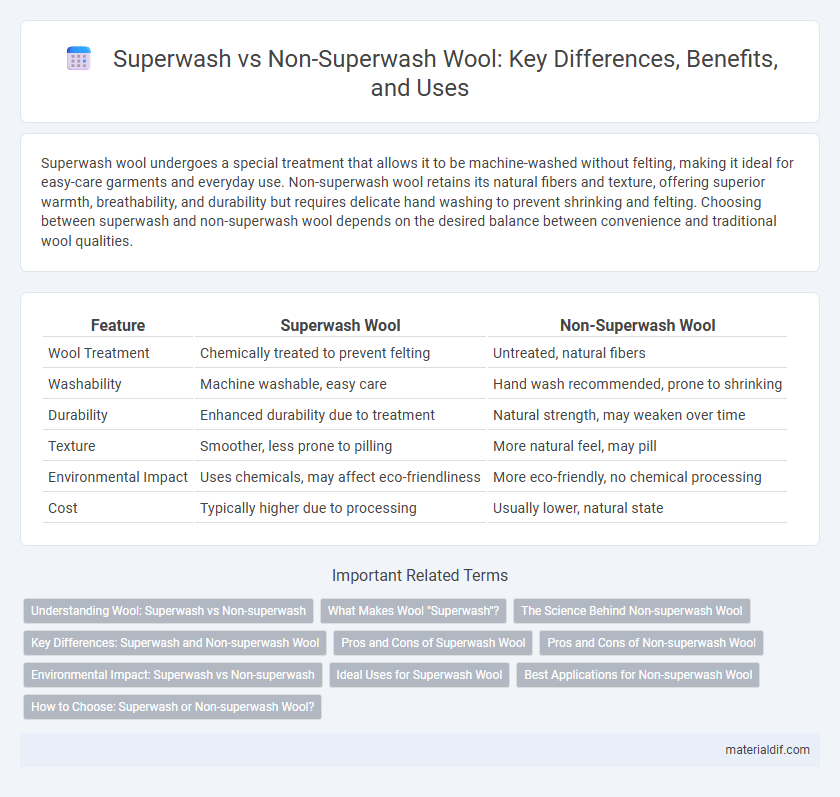Superwash wool undergoes a special treatment that allows it to be machine-washed without felting, making it ideal for easy-care garments and everyday use. Non-superwash wool retains its natural fibers and texture, offering superior warmth, breathability, and durability but requires delicate hand washing to prevent shrinking and felting. Choosing between superwash and non-superwash wool depends on the desired balance between convenience and traditional wool qualities.
Table of Comparison
| Feature | Superwash Wool | Non-Superwash Wool |
|---|---|---|
| Wool Treatment | Chemically treated to prevent felting | Untreated, natural fibers |
| Washability | Machine washable, easy care | Hand wash recommended, prone to shrinking |
| Durability | Enhanced durability due to treatment | Natural strength, may weaken over time |
| Texture | Smoother, less prone to pilling | More natural feel, may pill |
| Environmental Impact | Uses chemicals, may affect eco-friendliness | More eco-friendly, no chemical processing |
| Cost | Typically higher due to processing | Usually lower, natural state |
Understanding Wool: Superwash vs Non-superwash
Superwash wool undergoes a chemical treatment that removes or coats the wool scales, making it machine washable and resistant to felting, while non-superwash wool retains its natural scales and requires gentle hand washing to prevent shrinking. The Superwash process often involves chlorine or polymer coatings, which can affect the fiber's softness and environmental impact. Choosing between superwash and non-superwash wool depends on the intended use, care preferences, and desired texture of the finished product.
What Makes Wool "Superwash"?
Superwash wool undergoes a chemical treatment that coats the fibers with a polymer, preventing them from felting and shrinking during washing. This process removes or smooths the scales on the wool fibers, allowing the yarn to be machine washable without losing its softness or structure. Non-superwash wool retains its natural scales, making it more prone to shrinkage and felting when exposed to agitation or heat in washing machines.
The Science Behind Non-superwash Wool
Non-superwash wool retains its natural scales, which interlock during washing to create a protective barrier, preventing excessive felting and maintaining fiber strength. This natural structure allows for breathability and moisture-wicking properties, enhancing comfort and durability without chemical treatments. Unlike superwash wool, which undergoes a harsh chlorination process to smooth fiber scales, non-superwash wool preserves its ability to develop a natural felted texture over time, contributing to its resilience and eco-friendly qualities.
Key Differences: Superwash and Non-superwash Wool
Superwash wool undergoes a chemical treatment that removes or coats the scales on the fibers, making it machine-washable and resistant to felting or shrinking. Non-superwash wool retains its natural scales, offering superior warmth, breathability, and elasticity, but it requires hand washing to prevent shrinkage and felting. The key differences lie in care requirements, durability, fiber treatment, and the balance between convenience and natural fiber properties.
Pros and Cons of Superwash Wool
Superwash wool undergoes a chemical treatment that makes it machine washable and resistant to felting, offering convenience and ease of care compared to non-superwash wool, which requires gentle hand washing to maintain its texture and durability. While superwash wool provides increased convenience, it can be less breathable and slightly less warm due to the treatment process, potentially reducing the natural insulating properties of untreated wool fibers. Non-superwash wool retains all natural qualities including superior moisture-wicking and temperature regulation, but demands more careful maintenance to prevent shrinking or felting.
Pros and Cons of Non-superwash Wool
Non-superwash wool retains its natural lanolin and delicate fiber structure, making it more breathable, warmer, and eco-friendly compared to superwash variants. Its fibers tend to felt and shrink without special care, requiring gentle hand washing and careful drying to preserve garment shape. Non-superwash wool offers superior durability and softness but demands more maintenance and is less resistant to shrinking in machine washing.
Environmental Impact: Superwash vs Non-superwash
Superwash wool undergoes chemical treatments using chlorine and coatings like polymer resin to prevent felting, which can release harmful pollutants into waterways during production and washing. Non-superwash wool, untreated and biodegradable, avoids these chemical processes, resulting in a lower environmental footprint and better compatibility with eco-friendly practices. Choosing non-superwash wool supports sustainable textile production by minimizing toxic waste and enhancing natural fiber biodegradability.
Ideal Uses for Superwash Wool
Superwash wool, treated to resist felting and shrinking, is ideal for garments requiring easy care and frequent washing, such as socks, baby clothes, and activewear. Its durability maintains softness and shape after multiple machine washes, making it popular for everyday wear and travel clothing. Non-superwash wool offers superior warmth and breathability but demands gentle hand washing to prevent damage.
Best Applications for Non-superwash Wool
Non-superwash wool retains its natural lanolin and scales, offering superior warmth, breathability, and durability compared to treated fibers. These qualities make non-superwash wool ideal for outdoor garments, heavy sweaters, and traditional knitwear that benefit from natural water resistance and insulation. Its untreated nature also suits felting projects and hand-dyed textiles where texture and fiber integrity are paramount.
How to Choose: Superwash or Non-superwash Wool?
Choosing between superwash and non-superwash wool depends on the desired care and durability of your garment. Superwash wool is treated to be machine washable and resists felting, making it ideal for easy-care clothing, while non-superwash wool retains its natural fibers and lanolin, offering superior warmth and softness but requires hand washing to prevent shrinking. Consider the balance between convenience and traditional wool qualities to select the best type for your knitting or sewing project.
Superwash vs Non-superwash Infographic

 materialdif.com
materialdif.com